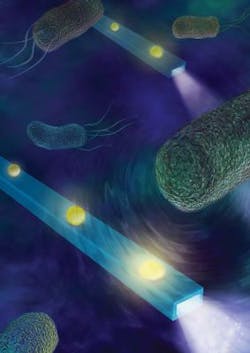Highly sensitive mini optical fiber device detects minute forces, sounds in cells
A team of researchers at the University of California San Diego (La Jolla, CA) has developed a nano-sized optical fiber device that is sensitive enough to feel the forces generated by swimming bacteria, and hear the beating of heart muscle cells.
Related: Suspended-core fiber with sensing nanoparticles could benefit healthcare
The nanofiber device demonstrated force detection down to 160 fN when placed in a solution containing live Helicobacter pylori bacteria (which are found in the digestive tract). In cultures of beating heart muscle cells from mice, the device was shown to detect sounds down to -30 dB—a level that is 1000X below the limit of the human ear.
Some applications for the device include detecting the presence and activity of a single bacterium; monitoring bonds forming and breaking; sensing changes in a cell's mechanical behavior that might signal it becoming cancerous or being attacked by a virus; or a mini stethoscope to monitor cellular acoustics in vivo, says nanoengineering professor Donald Sirbuly at the UC San Diego Jacobs School of Engineering, who led the study.
The optical fiber developed by Sirbuly and colleagues is at least 10X more sensitive than an atomic force microscope (AFM), an instrument that can measure infinitesimally small forces generated by interacting molecules. And while AFMs are bulky devices, this optical fiber is only several hundred nanometers in diameter.
The device is made from an extremely thin fiber of tin dioxide, coated with a thin layer of a polymer called polyethylene glycol, and studded with gold nanoparticles. To use the device, researchers dip the nanofiber into a solution of cells, send a beam of light down the fiber, and analyze the light signals. These signals, based on their intensity, indicate how much force or sound the fiber is picking up from the surrounding cells.
As light travels down the optical fiber, it interacts strongly with the gold nanoparticles, which then scatter the light as signals that can be seen with a conventional microscope. These light signals show up at a particular intensity. But that intensity changes when the fiber is placed in a solution containing live cells. Forces and sound waves from the cells hit the gold nanoparticles, pushing them into the polymer layer that separates them from the fiber's surface. Pushing the nanoparticles closer to the fiber allows them to interact more strongly with the light coming down the fiber, thus increasing the intensity of the light signals. Researchers calibrated the device so they could match the signal intensities to different levels of force or sound.
The key to making this work is the fiber's polymer layer, which is tunable—if researchers want to measure larger forces, they can use a stiffer polymer coating or, for increased sensitivity, can use a softer polymer like a hydrogel.
Moving forward, the researchers plan to use the nanofibers to measure bio-activity and the mechanical behavior of single cells. Future work also includes improving the fibers' "listening" capabilities to create ultrasensitive biological stethoscopes, and tuning their acoustic response to develop new imaging techniques.
Full details of the work appear in the journal Nature Photonics; for more information, please visit http://dx.doi.org/10.1038/nphoton.2017.74.

